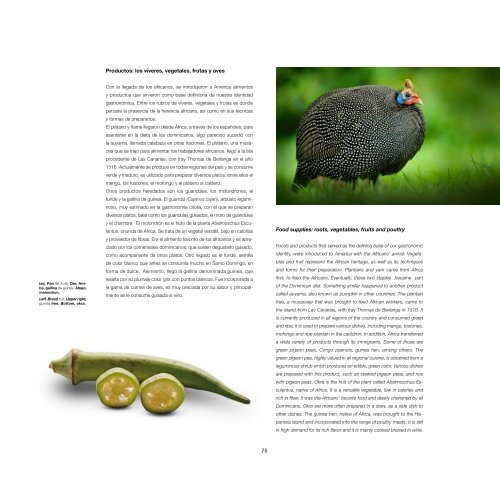Sabores-Ancestrales-Digital-1
You also want an ePaper? Increase the reach of your titles
YUMPU automatically turns print PDFs into web optimized ePapers that Google loves.
Productos: los víveres, vegetales, frutas y aves<br />
Izq. Pan de fruta. Der. Arriba,<br />
gallina de guinea. Abajo,<br />
molondrón.<br />
Left. Bread fruit. Upper right,<br />
guinea hen. Bottom, okra.<br />
Con la llegada de los africanos, se introdujeron a América alimentos<br />
y productos que sirvieron como base definitoria de nuestra identidad<br />
gastronómica. Entre los rubros de víveres, vegetales y frutas es donde<br />
persiste la presencia de la herencia africana, así como en sus técnicas<br />
y formas de prepararlos.<br />
El plátano y ñame llegaron desde África, a través de los españoles, para<br />
asentarse en la dieta de los dominicanos, algo parecido sucedió con<br />
la auyama, llamada calabaza en otras naciones. El plátano, una musácea<br />
que se trajo para alimentar los trabajadores africanos, llegó a la isla<br />
procedente de Las Canarias, con fray Thomas de Berlanga en el año<br />
1516. Actualmente se produce en todas regiones del país y se consume<br />
verde y maduro; es utilizado para preparar diversos platos, entre ellos el<br />
mangú, los tostones, el mofongo y el plátano al caldero.<br />
Otros productos heredados son los guandules, los molondrones, el<br />
funde y la gallina de guinea. El guandul (Cajanus cajan), arbusto leguminoso,<br />
muy estimado en la gastronomía criolla, con el que se preparan<br />
diversos platos, tales como los guandules guisados, el moro de guandules<br />
y el chambre. El molondrón es el fruto de la planta Abelmoschus Esculentus,<br />
oriunda de África. Se trata de un vegetal versátil, bajo en calorías<br />
y proveedor de fibras. Era el alimento favorito de los africanos y es apreciado<br />
por los comensales dominicanos, que suelen degustarlo guisado,<br />
como acompañante de otros platos. Otro legado es el funde, semilla<br />
de color blanco que antes se consumía mucho en Santo Domingo, en<br />
forma de dulce. Asimismo, llegó la gallina denominada guinea, que<br />
resalta por su plumaje color gris con puntos blancos. Fue incorporada a<br />
la gama de carnes de aves; es muy preciada por su sabor y principalmente<br />
se le consume guisada al vino.<br />
Food supplies: roots, vegetables, fruits and poultry<br />
Foods and products that served as the defining base of our gastronomic<br />
identity, were introduced to America with the Africans’ arrival. Vegetables<br />
and fruit represent the African heritage, as well as its techniques<br />
and forms for their preparation. Plantains and yam came from Africa<br />
first, to feed the Africans. Eventually, these two staples became part<br />
of the Dominican diet. Something similar happened to another product<br />
called auyama, also known as pumpkin in other countries. The plantain<br />
tree, a musaceae that was brought to feed African workers, came to<br />
the island from Las Canarias, with fray Thomas de Berlanga in 1516. It<br />
is currently produced in all regions of the country and consumed green<br />
and ripe; It is used to prepare various dishes, including mangú, tostones,<br />
mofongo and ripe plantain in the cauldron. In addition, Africa transferred<br />
a wide variety of products through its immigrants. Some of those are<br />
green pigeon peas, Congo peanuts, guinea hen, among others. The<br />
green pigeon pea, highly valued in all regional cuisine, is obtained from a<br />
leguminous shrub which produces an edible, green color. Various dishes<br />
are prepared with this product, such as stewed pigeon peas, and rice<br />
with pigeon peas. Okra is the fruit of the plant called Abelmoschus Esculentus,<br />
native of Africa. It is a versatile vegetable, low in calories and<br />
rich in fiber. It was the Africans’ favorite food and dearly cherished by all<br />
Dominicans. Okra are more often prepared in a stew, as a side dish to<br />
other dishes. The guinea hen, native of Africa, was brought to the Hispaniola<br />
island and incorporated into the range of poultry meats. It is still<br />
in high demand for its rich flavor and it is mainly cooked braised in wine.<br />
75


